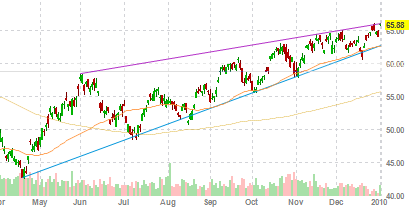Wedge Pattern
WEDGE PATTERN
a temporary stop of the primary trend
Characteristics:
1. It is a contracting range in prices;
2. This is coupled with an upward trend in prices (the rising wedge) or
3. It is paired with a downward movement of prices (the falling wedge).
Brief Explanation:
A wedge pattern is considered to be a temporary stop of the primary trend. It is a type of formation in which trading activities are confined within converging straight lines which form a pattern. The wedge should be completed in 3 to 4 weeks. This pattern has a rising or falling slant pointing in the same direction.
It differs from the triangle because both boundary lines either slope up or down. Price breaking out point creates another difference from the triangle. Falling and rising wedges are a small part of the major trend. As they are reserved for minor trends, they are not counted as major patterns. Once the primary trend resumes itself, the wedge pattern loses its effectiveness as a technical indicator.
Falling Wedge (Also called a downward wedge)
The falling wedge pattern is indicated by a chart pattern that forms when the market makes lower lows and lower highs with a range that is contracting. When this pattern is on a downward trend, it is seen as a reversal pattern. The contraction of the range indicates the downtrend is losing its power.
When this pattern is on an uptrend market, it is counted as bullish. As the market range becomes narrower into the correction, this indicates that the downward trend is losing steam and the uptrend is expected to continue soon.
Rising Wedge (also called an upward wedge)
The rising wedge pattern is distinguished by a chart pattern which forms when the market makes higher highs and higher lows with a range that is contracting. When this pattern is on an uptrend market, it is counted as a reversal pattern. The contraction of the range indicates that the uptrend is losing steam.
When this pattern is on a downtrend, it is counted as a bullish. As the market range becomes narrower into the correction, this indicates that the correction is losing steam. A downtrend is expected to continue soon when this happens.
